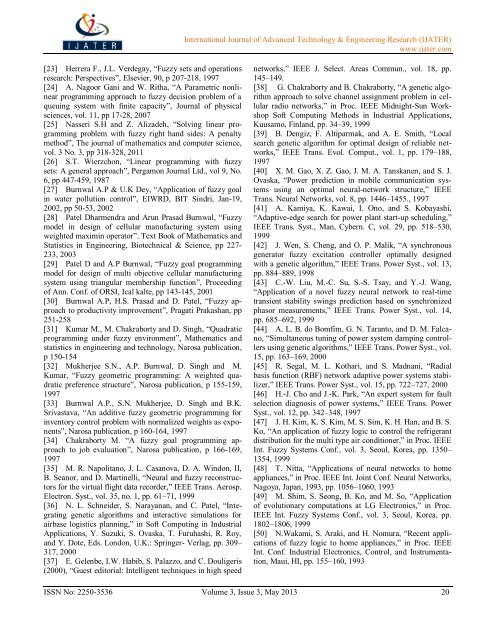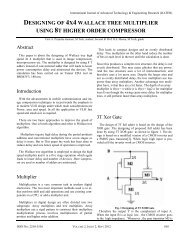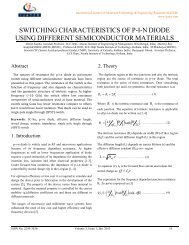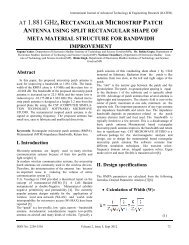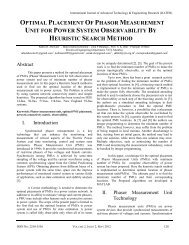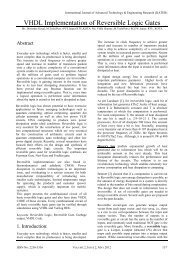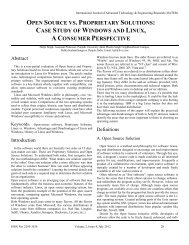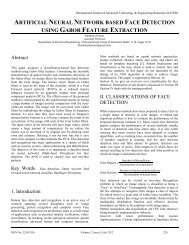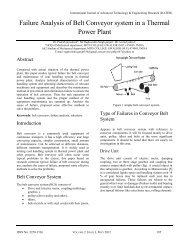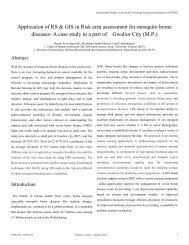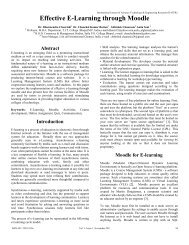assessment of fuzzy set theory in different paradigm - ijater
assessment of fuzzy set theory in different paradigm - ijater
assessment of fuzzy set theory in different paradigm - ijater
You also want an ePaper? Increase the reach of your titles
YUMPU automatically turns print PDFs into web optimized ePapers that Google loves.
International Journal <strong>of</strong> Advanced Technology & Eng<strong>in</strong>eer<strong>in</strong>g Research (IJATER)www.<strong>ijater</strong>.com[23] Herrera F., J.L. Verdegay, “Fuzzy <strong>set</strong>s and operationsresearch: Perspectives”, Elsevier, 90, p 207-218, 1997[24] A. Nagoor Gani and W. Ritha, “A Parametric nonl<strong>in</strong>earprogramm<strong>in</strong>g approach to <strong>fuzzy</strong> decision problem <strong>of</strong> aqueu<strong>in</strong>g system with f<strong>in</strong>ite capacity”, Journal <strong>of</strong> physicalsciences, vol. 11, pp 17-28, 2007[25] Nasseri S.H and Z. Alizadeh, “Solv<strong>in</strong>g l<strong>in</strong>ear programm<strong>in</strong>gproblem with <strong>fuzzy</strong> right hand sides: A penaltymethod”, The journal <strong>of</strong> mathematics and computer science,vol. 3 No. 3, pp 318-328, 2011[26] S.T. Wierzchon, “L<strong>in</strong>ear programm<strong>in</strong>g with <strong>fuzzy</strong><strong>set</strong>s: A general approach”, Pergamon Journal Ltd., vol 9, No.6, pp 447-459, 1987[27] Burnwal A.P & U.K Dey, “Application <strong>of</strong> <strong>fuzzy</strong> goal<strong>in</strong> water pollution control”, EIWRD, BIT S<strong>in</strong>dri, Jan-19,2002, pp 50-53, 2002[28] Patel Dharmendra and Arun Prasad Burnwal, “Fuzzymodel <strong>in</strong> design <strong>of</strong> cellular manufactur<strong>in</strong>g system us<strong>in</strong>gweighted maxim<strong>in</strong> operator”. Text Book <strong>of</strong> Mathematics andStatistics <strong>in</strong> Eng<strong>in</strong>eer<strong>in</strong>g, Biotechnical & Science, pp 227-233, 2003[29] Patel D and A.P Burnwal, “Fuzzy goal programm<strong>in</strong>gmodel for design <strong>of</strong> multi objective cellular manufactur<strong>in</strong>gsystem us<strong>in</strong>g triangular membership function”, Proceed<strong>in</strong>g<strong>of</strong> Ann. Conf. <strong>of</strong> ORSI, Ical kalte, pp 143-145, 2001[30] Burnwal A.P, H.S. Prasad and D. Patel, “Fuzzy approachto productivity improvement”, Pragati Prakashan, pp251-258[31] Kumar M., M. Chakraborty and D. S<strong>in</strong>gh, “Quadraticprogramm<strong>in</strong>g under <strong>fuzzy</strong> environment”, Mathematics andstatistics <strong>in</strong> eng<strong>in</strong>eer<strong>in</strong>g and technology, Narosa publication,p 150-154[32] Mukherjee S.N., A.P. Burnwal, D. S<strong>in</strong>gh and M.Kumar, “Fuzzy geometric programm<strong>in</strong>g: A weighted quadraticpreference structure”, Narosa publication, p 155-159,1997[33] Burnwal A.P., S.N. Mukherjee, D. S<strong>in</strong>gh and B.K.Srivastava, “An additive <strong>fuzzy</strong> geometric programm<strong>in</strong>g for<strong>in</strong>ventory control problem with normalized weights as exponents”,Narosa publication, p 160-164, 1997[34] Chakraborty M. “A <strong>fuzzy</strong> goal programm<strong>in</strong>g approachto job evaluation”, Narosa publication, p 166-169,1997[35] M. R. Napolitano, J. L. Casanova, D. A. W<strong>in</strong>don, II,B. Seanor, and D. Mart<strong>in</strong>elli, “Neural and <strong>fuzzy</strong> reconstructorsfor the virtual flight data recorder,” IEEE Trans. Aerosp.Electron. Syst., vol. 35, no. 1, pp. 61–71, 1999[36] N. L. Schneider, S. Narayanan, and C. Patel, “Integrat<strong>in</strong>ggenetic algorithms and <strong>in</strong>teractive simulations forairbase logistics plann<strong>in</strong>g,” <strong>in</strong> S<strong>of</strong>t Comput<strong>in</strong>g <strong>in</strong> IndustrialApplications, Y. Suzuki, S. Ovaska, T. Furuhashi, R. Roy,and Y. Dote, Eds. London, U.K.: Spr<strong>in</strong>ger- Verlag, pp. 309–317, 2000[37] E. Gelenbe, I.W. Habib, S. Palazzo, and C. Douligeris(2000), “Guest editorial: Intelligent techniques <strong>in</strong> high speednetworks,” IEEE J. Select. Areas Commun., vol. 18, pp.145–149.[38] G. Chakraborty and B. Chakraborty, “A genetic algorithmapproach to solve channel assignment problem <strong>in</strong> cellularradio networks,” <strong>in</strong> Proc. IEEE Midnight-Sun WorkshopS<strong>of</strong>t Comput<strong>in</strong>g Methods <strong>in</strong> Industrial Applications,Kuusamo, F<strong>in</strong>land, pp. 34–39, 1999[39] B. Dengiz, F. Altiparmak, and A. E. Smith, “Localsearch genetic algorithm for optimal design <strong>of</strong> reliable networks,”IEEE Trans. Evol. Comput., vol. 1, pp. 179–188,1997[40] X. M. Gao, X. Z. Gao, J. M. A. Tanskanen, and S. J.Ovaska, “Power prediction <strong>in</strong> mobile communication systemsus<strong>in</strong>g an optimal neural-network structure,” IEEETrans. Neural Networks, vol. 8, pp. 1446–1455., 1997[41] A. Kamiya, K. Kawai, I. Ono, and S. Kobayashi,“Adaptive-edge search for power plant start-up schedul<strong>in</strong>g,”IEEE Trans. Syst., Man, Cybern. C, vol. 29, pp. 518–530,1999[42] J. Wen, S. Cheng, and O. P. Malik, “A synchronousgenerator <strong>fuzzy</strong> excitation controller optimally designedwith a genetic algorithm,” IEEE Trans. Power Syst., vol. 13,pp. 884–889, 1998[43] C.-W. Liu, M.-C. Su, S.-S. Tsay, and Y.-J. Wang,“Application <strong>of</strong> a novel <strong>fuzzy</strong> neural network to real-timetransient stability sw<strong>in</strong>gs prediction based on synchronizedphasor measurements,” IEEE Trans. Power Syst., vol. 14,pp. 685–692, 1999[44] A. L. B. do Bomfim, G. N. Taranto, and D. M. Falcano,“Simultaneous tun<strong>in</strong>g <strong>of</strong> power system damp<strong>in</strong>g controllersus<strong>in</strong>g genetic algorithms,” IEEE Trans. Power Syst., vol.15, pp. 163–169, 2000[45] R. Segal, M. L. Kothari, and S. Madnani, “Radialbasis function (RBF) network adaptive power systems stabilizer,”IEEE Trans. Power Syst., vol. 15, pp. 722–727, 2000[46] H.-J. Cho and J.-K. Park, “An expert system for faultselection diagnosis <strong>of</strong> power systems,” IEEE Trans. PowerSyst., vol. 12, pp. 342–348, 1997[47] J. H. Kim, K. S. Kim, M. S. Sim, K. H. Han, and B. S.Ko, “An application <strong>of</strong> <strong>fuzzy</strong> logic to control the refrigerantdistribution for the multi type air conditioner,” <strong>in</strong> Proc. IEEEInt. Fuzzy Systems Conf., vol. 3, Seoul, Korea, pp. 1350–1354, 1999[48] T. Nitta, “Applications <strong>of</strong> neural networks to homeappliances,” <strong>in</strong> Proc. IEEE Int. Jo<strong>in</strong>t Conf. Neural Networks,Nagoya, Japan, 1993, pp. 1056–1060, 1993[49] M. Shim, S. Seong, B. Ko, and M. So, “Application<strong>of</strong> evolutionary computations at LG Electronics,” <strong>in</strong> Proc.IEEE Int. Fuzzy Systems Conf., vol. 3, Seoul, Korea, pp.1802–1806, 1999[50] N.Wakami, S. Araki, and H. Nomura, “Recent applications<strong>of</strong> <strong>fuzzy</strong> logic to home appliances,” <strong>in</strong> Proc. IEEEInt. Conf. Industrial Electronics, Control, and Instrumentation,Maui, HI, pp. 155–160, 1993ISSN No: 2250-3536 Volume 3, Issue 3, May 2013 20


